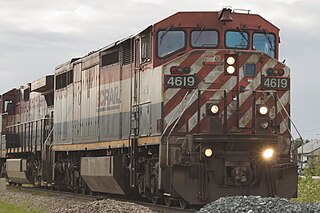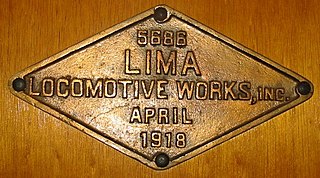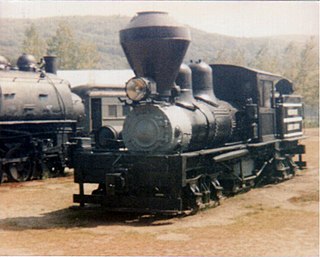
A geared steam locomotive is a type of steam locomotive which uses gearing, usually reduction gearing, in the drivetrain, as opposed to the common directly driven design.

The Shay locomotive is a geared steam locomotive that originated and was primarily used in North America. The locomotives were built to the patents of Ephraim Shay, who has been credited with the popularization of the concept of a geared steam locomotive. Although the design of Ephraim Shay's early locomotives differed from later ones, there is a clear line of development that joins all Shays. Shay locomotives were especially suited to logging, mining and industrial operations and could operate successfully on steep or poor quality track.

The British Columbia Railway Company, commonly known as BC Rail, is a railway in the Canadian province of British Columbia.

The California State Railroad Museum is a museum in the California State Parks system that interprets the role of railroads in the Western U.S.. It is located in Old Sacramento State Historic Park at 111 I Street, Sacramento, California.

Lima Locomotive Works (LLW) was an American firm that manufactured railroad locomotives from the 1870s through the 1950s. The company's name is derived from the location of its main manufacturing plant in Lima, Ohio. The shops were located between the Erie Railroad main line, the Baltimore & Ohio's Cincinnati-Toledo main line and the Nickel Plate Road main line and shops.

The Royal Hudsons are a series of semi-streamlined 4-6-4 "Hudson" type steam locomotives formerly owned and operated by the Canadian Pacific Railway (CPR) and built by Montreal Locomotive Works (MLW). The engines were built in 1937. In 1939, King George VI allowed the CPR to use the term after Royal Hudson number 2850 transported the royal train across Canada with no need of replacement. These locomotives were in service between 1937 and 1960. Four of them have been preserved. No. 2839 was used to power excursions for the Southern Railway Steam Program between 1979 and 1980. No. 2860 was used for excursion service in British Columbia between 1974 and 1999, then again between 2006 and 2010.

A steam donkey or donkey engine is a steam-powered winch once widely used in logging, mining, maritime, and other industrial applications.

The Kamloops Heritage Railway is a heritage railway in Kamloops, British Columbia. The railway operates throughout the year running trains within Kamloops. The train is pulled by restored steam locomotive Canadian National Railway 2141, the "Spirit of Kamloops".

The Alberni Pacific Railway is a heritage railway originating in Port Alberni, British Columbia. The Alberni Pacific Railway returned to operations along the Port Alberni Waterfront in Summer of 2024, and is expected to run until the end of September. The Santa Train will also return in 2024 along with other popular events. www.albernipacificrailway.ca is where you can find out about the 2024 Operations.
The Rocky Mountain Rail Society (RMRS) is a registered nonprofit organization of volunteers dedicated to the preservation of Canadian National Railway steam locomotive 6060, The Spirit of Alberta. Their goal is to ensure that The Spirit of Alberta remains in full and complete operating condition for the enjoyment of steam rail fans.

The GE 45-ton switcher is a 4-axle diesel locomotive built by General Electric between 1940 and 1956.

Engine No. 374 is the Canadian Pacific Railway (CPR) locomotive that pulled the first transcontinental passenger train to arrive in Vancouver, arriving on May 23, 1887. This was a year after sister Engine No. 371 brought the first train to cross Canada into Port Moody, roughly 20 miles (32 km) to the east.

Steamtown, U.S.A., was a steam locomotive museum that ran steam excursions out of North Walpole, New Hampshire, and Bellows Falls, Vermont, from the 1960s to 1983. The museum was founded by millionaire seafood industrialist F. Nelson Blount. The non-profit Steamtown Foundation took over operations following his death in 1967. Because of Vermont's air quality regulations restricting steam excursions, declining visitor attendance, and disputes over the use of track, some pieces of the collection were relocated to Scranton, Pennsylvania in the mid-1980s and the rest were auctioned off. After the move, Steamtown continued to operate in Scranton but failed to attract the expected 200,000–400,000 visitors. Within two years the tourist attraction was facing bankruptcy, and more pieces of the collection were sold to pay off debt.

Union Pacific 4466 is an 0-6-0 steam locomotive built in October 1920 by the Lima Locomotive Works for the Union Pacific Railroad (UP) to perform switching chores and transfer runs.

Union Pacific 618 is a class "C-2" 2-8-0 "Consolidation" type steam locomotive previously owned by the Union Pacific Railroad. The engine is now located in Heber City, Utah and owned by the Heber Valley Railroad. Built in July 1907 by the Baldwin Locomotive Works (BLW) of Eddystone, Pennsylvania, No. 618 is one of 2 surviving Oregon Short Line C-2 locomotives. The locomotive operated in revenue service until 1958. It was then donated to the State of Utah, where it sat on display for many years. In the mid 1960s, a full restoration effort began on the locomotive with the promise of heading up Utah's first tourist railroad in Heber City after the state donated the engine to the National Railway Historical Society. Today, it is one of UP's oldest locomotives and the first steam locomotive to be removed from a Public Park, and put back into operational condition in excursion service. The engine currently is out of service in Heber City, Utah undergoing restoration back to operating condition.

Valley Railroad 40 is a preserved 2-8-2 "Mikado" type steam locomotive that was built by Alco in August 1920. It was initially built as No. 101 for the Portland, Astoria and Pacific Railroad as part of their small order of locomotives. However, the order was cancelled, and the locomotive was subsequently sold to the Minarets and Western Railway to haul logging trains. No. 101 subsequently went through several ownerships during revenue service, until it was retired in 1950, and by that time, it was renumbered to 40. After spending several years in storage, No. 40 made its way to the Essex Steam Train and Riverboat in Essex in 1977. As of 2024, No. 40 is being used to haul tourist trains between Essex and Deep River, Connecticut, alongside 2-8-0 No. 97 and 2-8-2 No. 3025.

Canadian National 6060 is a 4-8-2 "Mountain"-type steam locomotive built in October 1944 by the Montreal Locomotive Works as the first of the U-1-f class for the Canadian National Railway (CN) in Canada. It was first assigned to haul passenger trains and eventually fast freight trains on the CN until its retirement in 1959. Three years later, CN engineer Harry R.J. Home purchased the locomotive for $1 and brought it to Jasper, Alberta, where No. 6060 was put on display near the Jasper station.

Canadian National 1392 is a preserved 4-6-0 "ten-wheeler" type steam locomotive. It was built in 1913 by the Montreal Locomotive Works originally for the Canadian Northern Railway before it was absorbed into the Canadian National Railway. No. 1392 became famous in later years for pulling a plethora of small excursion trains throughout Western Canada. As of 2024, the locomotive is owned and operated by the Alberta Railway Museum and is based in Edmonton, Alberta.

Mount Emily Lumber Company No. 1 is a three-truck or 'Class C' Shay steam locomotive that was originally owned by the Mount Emily Lumber Company. It was built in 1923 by the Lima Locomotive Works and delivered to Lima's Seattle dealer, Hofius Steel and Equipment Company of Seattle, Washington. It was later sold to the Independence Logging Company of Independence, Washington, and then it was later sold to the Mount Emily Lumber Company of La Grande, Oregon. When it was retired in 1955, it was donated to the Oregon Museum of Science and Industry. Three years later, in 1958, it was donated to the Oregon Historical Society of Portland, Oregon. The engine was operational at Cass Scenic Railroad and the City of Prineville Railroad for many years. It was announced in 2022 that the Oregon Rail Heritage Foundation would be the new owners of No. 1.

Elk River Mill & Lumber Co. "Falk" No.1 is a 0-4-0 steam locomotive built by Marshutz and Centrell in 1884. This "gypsy" type locomotive was purchased by Noah Falk in San Francisco and shipped by vessel to Arcata, CA. It was first used at the Dolly Varden Mill in north Arcata until the mill was closed in 1885. In 1886, it was moved to Falk, California, for use on the Elk River Mill & Lumber Co. railroad. Logs were hauled from the woods to the mill. When the railroad was extended five miles up a narrow, winding canyon, a larger locomotive was purchased in 1903. The Falk was relegated to switching duties at the mill. In 1927 it was retired. The locomotive was given to the city of Eureka, California, for use in a 1936 Fourth of July parade operating on streetcar tracks.



















